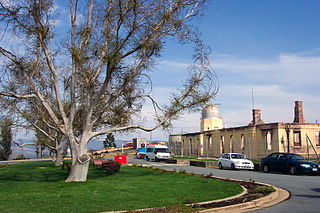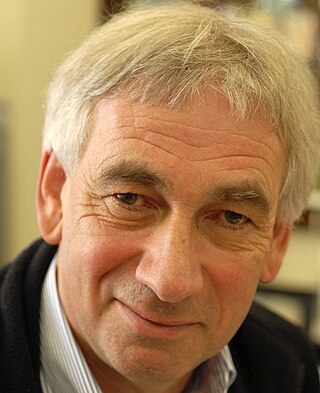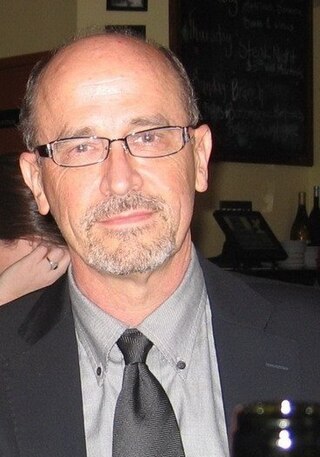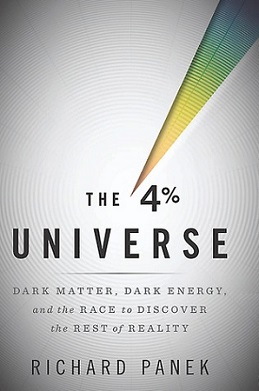
In cosmology, the cosmological constant, alternatively called Einstein's cosmological constant, is a coefficient that Albert Einstein initially added to his field equations of general relativity. He later removed it; however, much later it was revived to express the energy density of space, or vacuum energy, that arises in quantum mechanics. It is closely associated with the concept of dark energy.

Mount Stromlo Observatory located in the west of Canberra, Australia, is part of the Research School of Astronomy and Astrophysics at the Australian National University (ANU). Australia's oldest telescope and several others at the observatory were destroyed by bushfire in 2003.

Saul Perlmutter is a U.S. astrophysicist, a professor of physics at the University of California, Berkeley, where he holds the Franklin W. and Karen Weber Dabby Chair, and head of the International Supernova Cosmology Project at the Lawrence Berkeley National Laboratory. He is a member of both the American Academy of Arts & Sciences and the American Philosophical Society, and was elected a Fellow of the American Association for the Advancement of Science in 2003. He is also a member of the National Academy of Sciences. Perlmutter shared the 2006 Shaw Prize in Astronomy, the 2011 Nobel Prize in Physics, and the 2015 Breakthrough Prize in Fundamental Physics with Brian P. Schmidt and Adam Riess for providing evidence that the expansion of the universe is accelerating. Since 2021, he has been a member of the President’s Council of Advisors on Science and Technology (PCAST).

Richard Salisbury Ellis is Professor of Astrophysics at the University College London. He previously served as the Steele Professor of Astronomy at the California Institute of Technology (Caltech). He was awarded the 2011 Gold Medal of the Royal Astronomical Society, in 2022 the Royal Medal of the Royal Society and in 2023 the Gruber Prize in Cosmology.

Robert P. Kirshner is an American astronomer, Chief Program Officer for Science for the Gordon and Betty Moore Foundation, and the Clownes Research Professor of Science at Harvard University. Kirshner has worked in several areas of astronomy including the physics of supernovae, supernova remnants, the large-scale structure of the cosmos, and the use of supernovae to measure the expansion of the universe.
The Supernova Cosmology Project is one of two research teams that determined the likelihood of an accelerating universe and therefore a positive cosmological constant, using data from the redshift of Type Ia supernovae. The project is headed by Saul Perlmutter at Lawrence Berkeley National Laboratory, with members from Australia, Chile, France, Portugal, Spain, Sweden, the United Kingdom, and the United States.

Alexei Vladimir "Alex" Filippenko is an American astrophysicist and professor of astronomy at the University of California, Berkeley. Filippenko graduated from Dos Pueblos High School in Goleta, California. He received a Bachelor of Arts in physics from the University of California, Santa Barbara in 1979 and a Ph.D. in astronomy from the California Institute of Technology in 1984, where he was a Hertz Foundation Fellow. He was a postdoctoral Miller Fellow at Berkeley from 1984 to 1986 and was appointed to Berkeley's faculty in 1986. In 1996 and 2005, he was a Miller Research Professor, and he is currently a Senior Miller Fellow. His research focuses on supernovae and active galaxies at optical, ultraviolet, and near-infrared wavelengths, as well as on black holes, gamma-ray bursts, and the expansion of the Universe.

The High-Z Supernova Search Team was an international cosmology collaboration which used Type Ia supernovae to chart the expansion of the universe. The team was formed in 1994 by Brian P. Schmidt, then a post-doctoral research associate at Harvard University, and Nicholas B. Suntzeff, a staff astronomer at the Cerro Tololo Inter-American Observatory (CTIO) in Chile. The original team submitted a proposal on September 29, 1994 called A Pilot Project to Search for Distant Type Ia Supernova to the CTIO. The team on the first observing proposal comprised: Nicholas Suntzeff (PI); Brian Schmidt (Co-I); R. Chris Smith, Robert Schommer, Mark M. Phillips, Mario Hamuy, Roberto Aviles, Jose Maza, Adam Riess, Robert Kirshner, Jason Spyromilio, and Bruno Leibundgut. The project was awarded four nights of telescope time on the CTIO Víctor M. Blanco Telescope on the nights of February 25, 1995, and March 6, 24, and 29, 1995. The pilot project led to the discovery of supernova SN1995Y. In 1995, the HZT elected Brian P. Schmidt of the Mount Stromlo Observatory which is part of the Australian National University to manage the team.

Adam Guy Riess is an American astrophysicist and Bloomberg Distinguished Professor at Johns Hopkins University and the Space Telescope Science Institute. He is known for his research in using supernovae as cosmological probes. Riess shared both the 2006 Shaw Prize in Astronomy and the 2011 Nobel Prize in Physics with Saul Perlmutter and Brian P. Schmidt for providing evidence that the expansion of the universe is accelerating.

Nicholas B. Suntzeff is an American astronomer and cosmologist. He is a university distinguished professor and holds the Mitchell/Heep/Munnerlyn Chair of Observational Astronomy in the Department of Physics & Astronomy at Texas A&M University where he is director of the Astronomy Program. He is an observational astronomer specializing in cosmology, supernovae, stellar populations, and astronomical instrumentation. With Brian Schmidt he founded the High-z Supernova Search Team, which was honored with the Nobel Prize in Physics in 2011 to Schmidt and Adam Riess.

Christopher Stubbs is an experimental physicist on the faculty at Harvard University in both the Department of Physics and the Department of Astronomy. He is the Dean of Science at Harvard University and a former chair of Harvard's Department of Physics.

In physical cosmology and astronomy, dark energy is a proposed form of energy that affects the universe on the largest scales. Its primary effect is to drive the accelerating expansion of the universe. Assuming that the lambda-CDM model of cosmology is correct, dark energy dominates the universe, contributing 68% of the total energy in the present-day observable universe while dark matter and ordinary (baryonic) matter contribute 26% and 5%, respectively, and other components such as neutrinos and photons are nearly negligible. Dark energy's density is very low: 7×10−30 g/cm3, much less than the density of ordinary matter or dark matter within galaxies. However, it dominates the universe's mass–energy content because it is uniform across space.

The ANU College of Science is a college of the Australian National University (ANU) that delivers research and teaching in physical, life, mathematical, and environmental sciences, as well as science communication. The College is composed of the Research Schools of Astronomy & Astrophysics, Biology, Chemistry, Earth Sciences, and Physics; Fenner School of Environment and Society; Mathematical Sciences Institute; and Australian National Centre for the Public Awareness of Science.

The Calán/Tololo Supernova Survey was a supernova survey that ran from 1989 to 1995 at the University of Chile and the Cerro Tololo Inter-American Observatory to measure a Hubble diagram out to redshifts of 0.1. It was founded by Mario Hamuy, José Maza Sancho, Mark M. Phillips, and Nicholas B. Suntzeff in 1989 out of discussions at the UC Santa Cruz meeting on supernovae on how to improve the Hubble diagram using Type Ia supernovae. It was also motivated by the suggestion of Allan Sandage to restart a supernova survey after the Sandage and Tammann survey failed due to poor quality photographic plates in 1986. The Survey built on the original supernova survey of Maza done at the f/3 Maksutov Camera at the Cerro Roble Observatory of the University of Chile between 1979 and 1984. The Survey used the CTIO Curtis Schmidt telescope with IIa-O photographic plates, each plate covering a field of 25 sq-deg on the sky. The plates were developed and sent to Santiago Chile the next morning and searched for supernovae at the Department of Astronomy at the University of Chile. Any supernova candidates were then observed the next night using the 0.9m telescope at CTIO with a CCD camera. This was one of the first studies done in astronomy where the telescope time was scheduled to observe objects not yet discovered.

Pilar Ruiz-Lapuente is an astrophysicist working as a professor at the University of Barcelona. Her work has included research on type Ia supernovae. In 2004, she led the team that searched for the companion star to the white dwarf that became supernova SN 1572, observed by Tycho Brahe, among others. Ruiz-Lapuente's research on supernovae contributed to the discovery of the accelerating expansion of the universe.

William Henry Press is an astrophysicist, theoretical physicist, computer scientist, and computational biologist. He is a member of the U.S. National Academy of Sciences, the American Academy of Arts and Sciences, and the Council on Foreign Relations. In 1989, he was elected a Fellow of the American Physical Society "in recognition of important theoretical contributions to relativistic astrophysics and to cosmology" Other honors include the 1981 Helen B. Warner Prize for Astronomy. Press has been a member of the JASON defense advisory group since 1977 and is a past chair.

The 4 Percent Universe: Dark Matter, Dark Energy, and the Race to Discover the Rest of Reality is a nonfiction book by writer and professor Richard Panek and published by Houghton Mifflin Harcourt on January 10, 2011.

Bruno Leibundgut is a Swiss astronomer born in Basel. His work focuses on supernovae and cosmology. He was a member of the High-z Supernova Search Team and participated in the planning, development and start of the operations of the Very Large Telescope.

Warrick John Couch is an Australian professional astronomer. He is currently a professor at Swinburne University of Technology in Melbourne. He was previously the Director of Australia's largest optical observatory, the Australian Astronomical Observatory (AAO). He was also the president of the Australian Institute of Physics (2015–2017), and a non-executive director on the Board of the Giant Magellan Telescope Organization. He was a founding non-executive director of Astronomy Australia Limited.

Peter M. Garnavich is a faculty member of the Department of Physics and Astronomy at the University of Notre Dame. His primary research area is the study of supernovae and their diversity. He has also studied gamma ray bursts and cataclysmic variable stars. Garnavich is a member of a supernova search team that contributed to the discovery of dark energy in 1998. At Notre Dame, Garnavich has developed and participated in collaborations using the Spitzer Space Telescope, the Large Binocular Telescope, the Hubble Space Telescope, and the Kepler Space Telescope. He was named a fellow of the American Astronomical Society (AAS) in 2024.






















